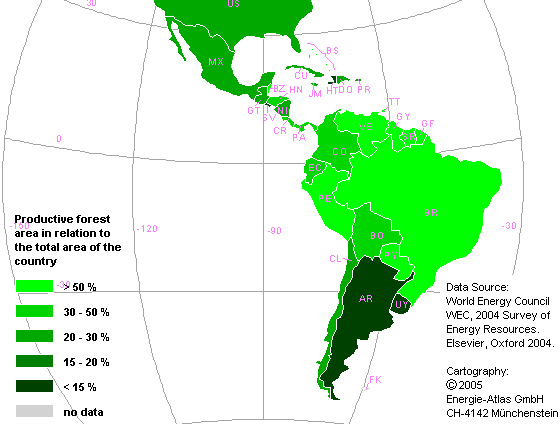|
Library >> Renewable Energy Resource Maps >> Latin America Renewable Energy Resources in LATIN AMERICABioenergy | Geothermal | Hydropower | Ocean | Solar | Wind All countries in the region are endowed with abundant renewable energy sources. Solar, wind, biomass, small hydro and other energy resources from the ocean, are available in the region in larger or smaller quantities, depending on the geographical location and morphology of the individual countries. The force of winds can be used to produce mechanical power and electricity by means of commercially available and cost-competitive technologies. Southeast Mexico and most Central American and Caribbean countries are under the influence of Trade Winds, while Southern Mexico and Central America are also exposed to strong and almost constant thermally driven winds. Windy places can also be found in the southern hemisphere. Solar energy is more evenly distributed, as good portions of Latin America lie within the so-called Sun Belt Region of highest solar radiation. Thus, except for site specific adverse microclimates, solar energy is a predictable and reliable resource. As a natural consequence of the solar radiation available, photosynthetic activity in most of the region is rather high, and hence the high production of biomass. On top of that, many countries have an economy based on agriculture, so that agricultural waste, forest residues and other residues from animal rising, which constitute another form of biomass, is also abundant. These resources are difficult to evaluate, so that information in aggregate and analyzed form is scarce. Most countries in the region use already a good portion of their hydraulic potential to generate electricity. However, most operations lie in the multi-megawatt range, seeking economies of scale characteristic of hydroelectric technologies. This practice has left a large portion of the small hydroelectric potential yet to be exploited. Given the high rainfall indices and the rough topography of many countries, small hydropower offers a good alternative to supply electricity, especially in remote sites. Wave and tidal power, along with other forms of energy available in the ocean, represent an enormous energy potential for many countries, especially when one considers the large coastline to inland ratio of most countries under consideration. Unfortunately, technologies to tap such energy resources are still far from commercialization. The down side of the renewable energy resource scenario in Latin America is the fact that little has been done to properly measure and characterize these resources, which represents a major barrier to the incorporation of this alternative as part of the national energy inventories and planning exercises. (1) (1) http://www.iea.org/textbase/work/2003/budapest/mexico.pdf#search=%22renewable%20energy%20latin%20america%22Related GENI Resources
Links
Renewable Energy News
|
Email this page to a friend
If you speak another language fluently and you liked this page, make
a contribution by translating
it! For additional translations check out FreeTranslation.com
(Voor vertaling van Engels tot Nederlands)
(For oversettelse fra Engelsk til Norsk)
(Для дополнительных
переводов проверяют
FreeTranslation.com )








